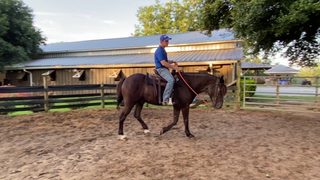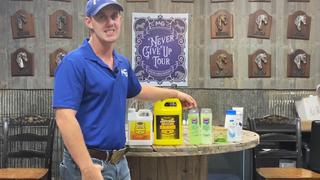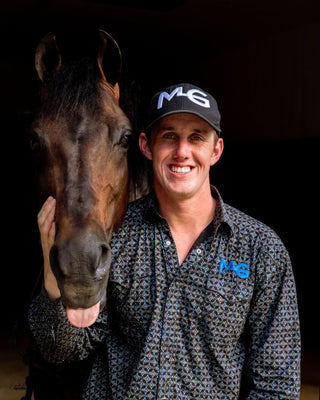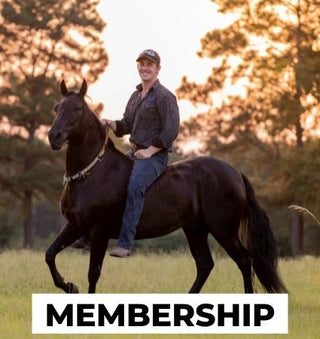Watch the Video Here or continue reading below!
Welcome back, horse enthusiasts. In Part 2 of our neck reining series, Michael Gascon continues the transformation of Rocket, a Rocky Mountain Horse, by building on the foundation of respect, responsiveness, and body control. This session is ideal for riders who have already completed Part 1 and the Respect Series.
Preparing to Neck Rein: Respect Before Refinement
Before introducing your horse to neck reining, ensure that:
-
The horse understands lateral movement and yields to leg pressure.
-
You’ve developed control through the Respect Series.
-
The horse is soft and responsive in the bridle.
-
You can easily move the horse away from pressure and into the opening created by your leg.
Without these basics, your horse will resist the neck rein and struggle to stay responsive, especially at higher speeds.
Softening the Body: Flexing in Motion
Rocket tends to come out stiff, so Michael starts by flexing him while in motion:
-
Flex the horse’s head to each side.
-
Release pressure as soon as the horse softens and follows the rein.
-
Repeat to encourage softness and lightness in the bridle.
The key to successful neck reining is ensuring the horse is flexible and respectful of directional cues.
The Foundation of Direction: Legs and Lines
Michael begins by exaggerating directional cues:
-
Ride in a straight line.
-
Look where you want to go.
-
Remove the inside leg to create an opening.
-
Release when the horse steps into the direction you're asking for.
Though not yet full neck reining, these early steps teach the horse to respond to subtle pressure changes and prepare them for the next phase.
Introducing Pressure: Spurs as a Reinforcement
If the horse does not move off the leg alone:
-
Add pressure with your spur on the opposite side.
-
Repeat until the horse responds by moving in the desired direction.
-
Release immediately to reward the correct response.
Sensitive horses may respond to just your calf, while others may require more pressure. Adjust based on your horse’s sensitivity.
One-Handed Rein Work: The Neck Rein Begins
Once the horse is soft and responsive, transition to one-handed riding:
-
Hold both reins in one hand and slide the outside rein across the horse’s neck.
-
Always return your hand to the center near the withers.
-
Use small bumps to direct the horse and reinforce your cues.
If the horse over-turns, correct them gently and bring them back on track. Prevent anticipation by making your signals deliberate and timed.
Keeping it Straight: Preventing Premature Turning
To avoid your horse anticipating turns:
-
Continue in a straight line until you decide to turn.
-
Use your body and hands to guide the horse, not just the reins.
-
Reinforce the habit of waiting for your cue.
By doing this, you prevent your horse from making assumptions and teach them to stay tuned in to your signals.
Advancing to the Trot: Adding Speed and Shape
Once the horse responds well at a walk, begin practicing at the trot:
-
Use unconventional patterns like triangles, rectangles, and hexagons.
-
Avoid repetitive circles to keep the horse mentally engaged.
-
Focus your eyes on a target to guide your path and add purpose to your lines.
These varied shapes help the horse stay attentive and responsive instead of falling into patterns.
Leg and Rein Coordination: Teaching True Responsiveness
Your long-term goal is to be able to move your horse with either your legs or reins independently:
-
When the horse gets stuck, pulse the rein and leg together.
-
Reinforce the connection between these two aids.
-
Eventually, your horse will respond to minimal input from either.
This level of responsiveness makes for a truly handy, one-handed horse.
From Two Hands to One: The Neck Reining Transformation
Even larger horses like Rocket, who are traditionally less sensitive, can become light and responsive with proper training. In just one week, you can:
-
Transition from two-handed to one-handed riding.
-
Refine the horse’s steering to come from the shoulders, not just the hindquarters.
-
Develop a horse that respects the bridle and searches for the right answer.
This is the essence of a reliable, well-trained neck reining horse.
Closing Thoughts
With consistency, patience, and clear communication, any horse can learn to neck rein well. Michael Gascon shows that even a big, strong horse like Rocket can become light, soft, and responsive in just a few sessions. The key lies in building trust, setting boundaries, and rewarding every correct try.
Thank you for following Rocket’s journey in Part 2 of our neck reining series. Be sure to check out the next video for more hands-on training with Michael Gascon.








